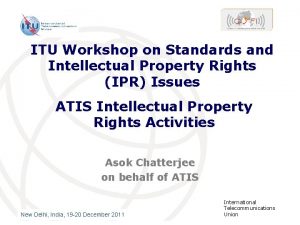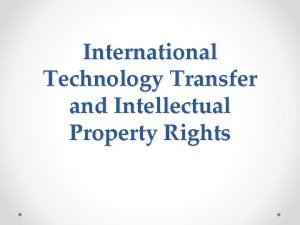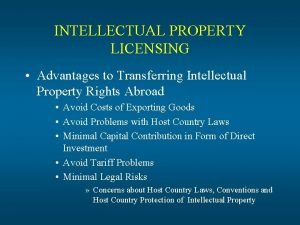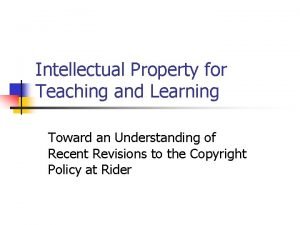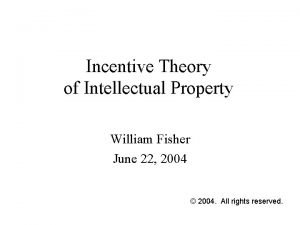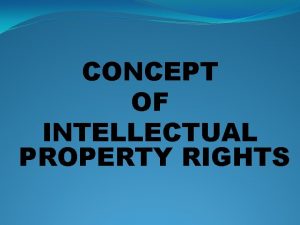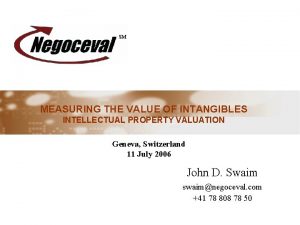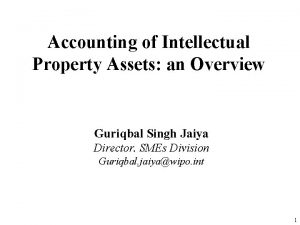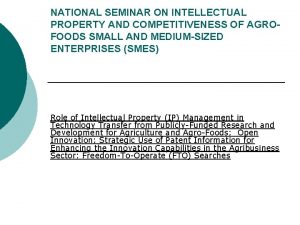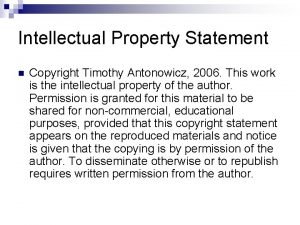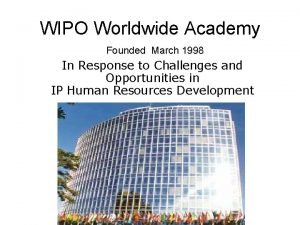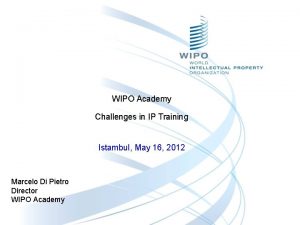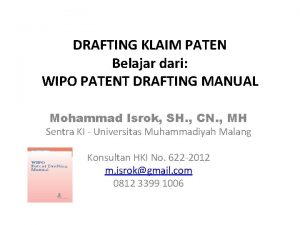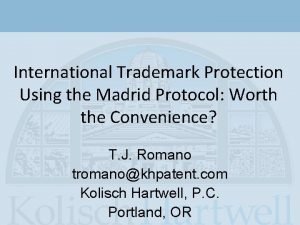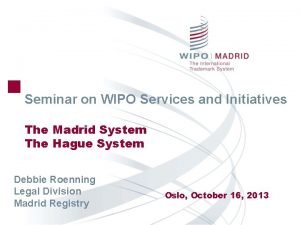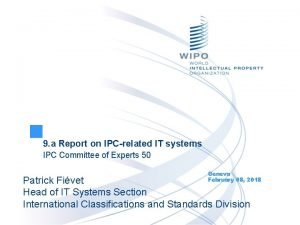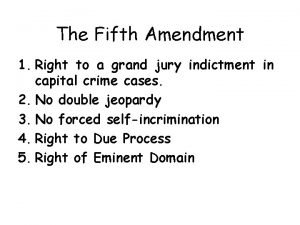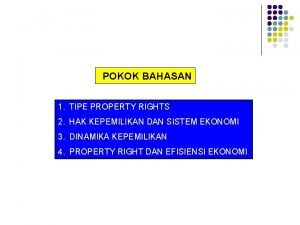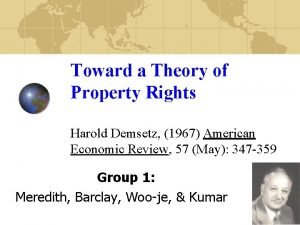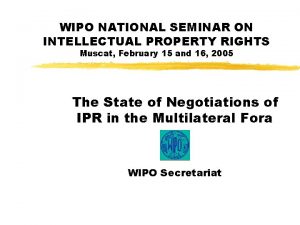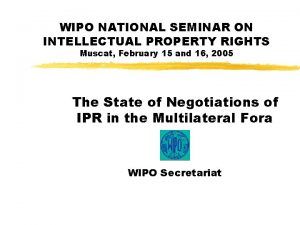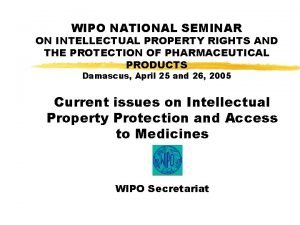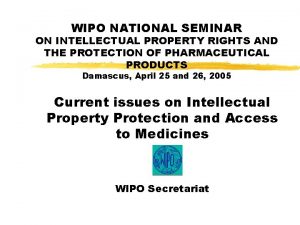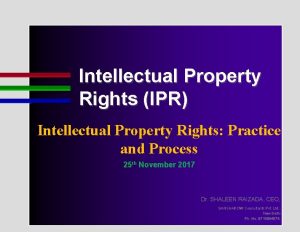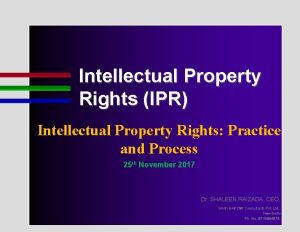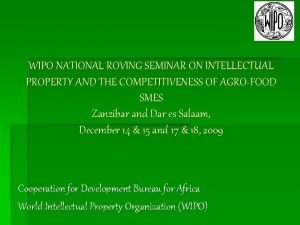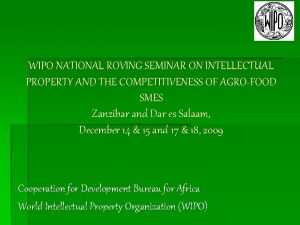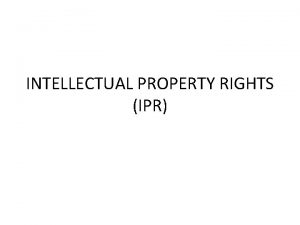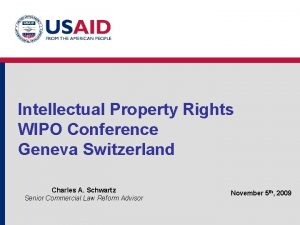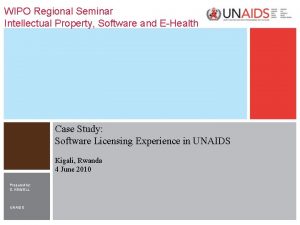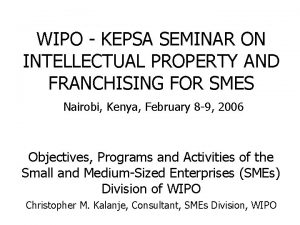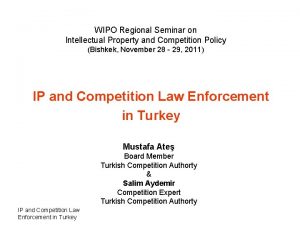WIPO NATIONAL SEMINAR ON INTELLECTUAL PROPERTY RIGHTS Muscat
















































- Slides: 48

WIPO NATIONAL SEMINAR ON INTELLECTUAL PROPERTY RIGHTS Muscat, February 15 and 16, 2005 An introduction to industrial property law and its international framework WIPO Secretariat

An Introduction to Industrial Property 1. An introduction to industrial property law - concept and components - IP in the global economy - the WTO response: the relative value of IP - the WIPO response: the absolute value of IP 2. International legal framework - main “substantive” treaties in the field of industrial property - the Paris Convention - the TRIPS Agreement 2

An Introduction to Industrial Property 1. An introduction to industrial property law 3

An Introduction to Industrial Property The concept and the components of industrial property law 4

An Introduction to Industrial Property Intellectual property is a set of principles and rules that regulate the acquisition, the use, the enforcement and the loss of rights and interests in intangible, differentiating assets that are susceptible of being used in commerce. 5

An Introduction to Industrial Property Intellectual property does not cover all intangible assets, but only those that serve as elements of differentiation among competitors. (For example, the rights of credit and other personal obligations are intangible assets, and yet they are not intellectual property. ) It is because it covers those differentiating elements only that aspects like novelty, originality, creativity, and distinctiveness are so crucial for intellectual property. IP, in short, is about preserving uniqueness. 6

An Introduction to Industrial Property On the other hand, intellectual property does not protect only the results of creativity and ingenuity. Indications of source, the merchants’ reputation and trademarks are elements of intellectual property that are not the product of creativity — they are, nonetheless, important as differentiation elements. 7

An Introduction to Industrial Property Intellectual property comprises two areas: a) copyright and related rights b) industrial property Copyright and related rights are the right to prevent others from copying (or from several modalities of copying, such as reproducing, fixing, translating, adapting or communicating) the protected work Industrial property is the right to prevent others from using the protected assets. 8

An Introduction to Industrial Property ) N. B. A cooking book provides for a good illustration of the difference. As the book is protected by copyright, the recipes it contains may not be reproduced. But the technical instructions they contain may be used for preparing the various dishes described. In contrast, if a patent is obtained for a new and inventive recipe, no one can use its technical instructions for cooking. But the patent itself, that is, the text describing the recipe’s technical specifications may be copied freely (actually, millions of valid and enforceable patents are available for downloading from the internet). 9

An Introduction to Industrial Property To some extent, the distinction between copyright and industrial property corresponds to the dichotomy idea v. expression. Generally, ideas are covered by industrial property rights. Expressions, in contrast, are the subject matter of copyright. 10

An Introduction to Industrial Property Industrial property comprises three sub-areas: a) proprietary technical creations (inventions, utility models, plant varieties, layout-designs (topographies) of integrated circuits, industrial designs); b) distinctive signs (trade and service marks, including collective marks; trade names; slogans; indications of source and geographical indications or appellations of origin); and c) non-proprietary competitive advantages (merchants’ reputation; good-will in general, comprising the trade dress; and undisclosed information, comprising trade secrets and test data). 11

An Introduction to Industrial Property (N. B. These three areas are partly overlapping. For example, industrial designs are technical creations, nevertheless they may serve as distinctive signs. Trade dress is a non-proprietary competitive advantage, but it constitutes a distinctive sign too. Likewise, there are some gray areas between copyright and industrial property. Industrial designs, for example, may be protected under copyright or under industrial property (TRIPS, Article 25. 2). The same goes for some computer programs (TRIPS, Articles 10. 1 and 27). Rights in plant varieties cover the reproduction of the protected subject matter because, as living beings, they may be used to reproduce themselves — plant varieties, however, are a part of industrial property and are assimilated to patent rights. ) 12

An Introduction to Industrial Property The social (economic, legal) function of intellectual property: like all other types of private property rights, it protects society against free riding in all its forms (parasitism, counterfeiting, unfair competition) in order to ensure a more efficient use of scarce resources and to avoid redundancy. (N. B. Depending on their particular nature, ip rights perform those functions in a special manner: patents, for example, help society to meter inventions; distinctive signs help society to reduce the costs of choosing products and services. ) 13

An Introduction to Industrial Property The social (economic, legal) function of intellectual property: (N. B. like all other private property rights, intellectual property only performs fully its social function in a free-market economic environment: a) the market must be reasonably free from government interference (if the market is shaped by the government, why should private entrepreneurs take the risks of seeking to extract rents from consumers? ) b) there must be a competitive environment (if there is no competition, there is nothing to differentiate; the reversal is also true: if there are no protected differentials, firms have no incentive to compete). 14

An Introduction to Industrial Property IP in the global economy 15

An Introduction to Industrial Property IP in the global economy Why is IP being “globalized” and harmonized? a) the increase in international trade and the need for reducing distortions and the barriers resulting from the lack of or insufficient protection of ip (non-tariff barriers) - IP as an element of market access b) transplantation of manufacturing units from developed countries to DCs implies the transplantation of the legal institutions (including rules on IP) from those same countries - IP as an element of access to foreign direct investment 16

An Introduction to Industrial Property IP in the global economy The current international debate on IP can be summarized by means of the following two questions: a) why should the (poor) peoples of DCs share the costs of R&D of goods and services (including R&D of pharmaceutical products) that is carried out in developed countries; those costs, shouldn’t they be born exclusively by the citizens of those developed countries? b) why should the functionality of IP be examined in an (harmonized) international perspective and not in a national one, that could take into account considerations of national industrial policy (that is, the asymmetries)? 17

An Introduction to Industrial Property IP in the global economy Responses: a) the WTO response: the relative value of IP; IP is good as far as it promotes free trade and eliminates distortions and barriers b) the WIPO response: the absolute value of IP; IP is a positive element of good governance and, as such, it promotes economic development 18

An Introduction to Industrial Property The WTO response: the relative value of IP 19

An Introduction to Industrial Property The relative value of IP . 1 One inventor resides in country A, a free-market oriented economy. He spends a large amount of money to develop a new product. He needs to recoup the investment from consumers — he will thus internalize the sunken costs of R&D into prices. If the invention is commercially successful, it is probable that in another country (country B) where it is not protected by a patent, a local manufacturer will reverse-engineer the process and will “copy” the product. Because the copier will not have R&D costs to recover, the copied product, if all other factors are equal, will be cheaper in B. 20

An Introduction to Industrial Property The relative value of IP . 2 Later, the inventor decides to export the product to country B, where he will face the competition of the local copier and his lower prices. Therefore, he will not be able to export his invention to country B. The lack of patent protection in country B operates as a non-tariff barrier to trade originated in country A. 21

An Introduction to Industrial Property The relative value of IP 3. In an international trade rationale, the government of country A may decide that, if country B does not eliminate that non-tariff barrier (i. e. if it does not adopt patent protection), country A will not eliminate barriers (such as tariffs, or subsidies) against trade from country B in other sectors, such as agriculture and textiles. 22

An Introduction to Industrial Property The relative value of IP 4. Country B, therefore, eliminates non-tariff barriers (i. e. it adopts patent protection) as a condition for having access to the market of country A. 5. IP acquires a relative value: it is of relevance if it helps in promoting access to other markets; but where it does not, IP can follow lower standards (authors’ moral rights, geographical indications) or even be eliminated (if so approved in the context of the WTO Dispute Settlement Mechanism) 23

An Introduction to Industrial Property The WIPO response: the absolute value of IP 24

An Introduction to Industrial Property The absolute value of IP Once upon a time, in a small island, suffering from drought, where fresh water could not be found. . . …the government passed a statute eliminating private property rights in fresh water. 25

An Introduction to Industrial Property The absolute value of IP Seeing his fellow citizens suffering from thirst, one citizen decided to import drinkable water. But when the first load of bottled drinkable water arrives at the harbor. . . 26

An Introduction to Industrial Property The absolute value of IP …a crowd rushes to the harbor. Thirsty citizens fetch all bottles of water. Law enforcement agencies can do nothing to prevent that, because the importer has no rights in the load. Unable to recoup his investment, the importer goes broke. Most probably no one else will take the risk of importing drinkable water again. 27

An Introduction to Industrial Property The absolute value of IP Stubborn, that same citizen tries again, but this time he hires a private army to protect the water load. . . On behalf of the community, the government decides to import drinkable water and, thus. . . or or …it establishes a state-owned company or agency (which will cost a lot of money that will be collected from tax-payers, even those who do not drink water, but fruit juice. . . ( …and spends a lot of money, which he internalizes into prices: water becomes very expensive, only the wealthy can afford it. The government reestablishes private property rights. and …establishes public property rights in order to avoid waste of public resources. The importer’s investment and risk are compensated by consumers; his rights are enforceable under the law; because water is an essential good, the government may monitor its price, quality and conditions of sale to the public. 28

An Introduction to Industrial Property The absolute value of IP Measures must be taken. . . but The success of the first importer. . . …to prevent the first importer from barring the entry of competitors (monopoly) and/or. . . …will naturally encourage others to seek to get a piece of the pie. The success of importers will naturally encourage local entrepreneurs to prospect drinkable water in the underground. …from conspiring with his competitors (oligopoly) to fix prices. 29

An Introduction to Industrial Property (N. B. The difference between the bottles of the drinkable water and technology, given its intangible nature, is that the latter may be used many times and it is never consumed. But the difference as regards the effectiveness of private property rights stops there. The “looting” of technology discourages private investment in R&D — as it discourages further imports of fresh water —, which brings us to the three subsequently alternative scenarios: technology is either protected by secrecy (where secrecy is not possible, technology is not created); or it is created by the government; or it is protected by private property rights. ) 30

An Introduction to Industrial Property 2. International legal framework 31

An Introduction to Industrial Property a. Substantive standards (concerning b. Adjective standards (concerning the acquisition, use and loss of rights) enforcement of rights) c. International registration and other procedural matters (enhancing access to internationally substantive protection) 32

An Introduction to Industrial Property a. Substantive standards (concerning the acquisition, use and loss of rights) (i) Paris Convention for the Protection of Industrial Property (1883) (the original purpose of the Paris Convention was simply articulating national regimes of protection regardless of their level of protection; later some minimum standards on patents and trademarks were incorporated as well minimum obligations on trade names, industrial designs, geographical indications and unfair competition) (ii) Madrid Agreement for the Repression of False or Deceptive Indications of Source on Goods (1891) (later partly incorporated into the Paris Convention) (iii) Lisbon Agreement for the Protection and Registration of Appellations of Origin and their International Registration (1958) (including standards and procedural aspects) 33

An Introduction to Industrial Property a. Substantive standards (cont. ) (iv) Nairobi Treaty on the Protection of the Olympic Symbol (1981) (v) Washington Treaty on Intellectual Property in Respect of Integrated Circuits (1989) (never entered into force but was later partly incorporated into the TRIPS Agreement; N. B. The Treaty does not deal with integrated circuits as such, but with their layout-designs (known as “topographies”) (vi) Agreement on Trade-Related Aspects of Intellectual Property Rights (TRIPS Agreement) (1994) 34

An Introduction to Industrial Property b. Adjective standards (concerning the enforcement of rights) (i) Paris Convention for the Protection of Industrial Property (1883) (ii) Madrid Agreement for the Repression of False or Deceptive Indications of Source on Goods (1891) (iii) Agreement on Trade-Related Aspects of Intellectual Property Rights (TRIPS Agreement) (1994) 35

An Introduction to Industrial Property c. International registration and other procedural matters (enhancing access to national and/or international substantive protection) (i) Madrid Agreement Concerning the International registration of Trademarks (1891) and Protocol Relating to the Madrid Agreement (1989) (ii) Hague Agreement Concerning the International Deposit of Industrial Designs (1925) and Geneva Act (1999) (iii) Trademark Law Treaty (1954) (iv) Lisbon Agreement for the Protection and Registration of Appellations of Origin and their International Registration (1958) 36

An Introduction to Industrial Property c. International registration and other procedural matters (cont. ) (v) Patent Cooperation Treaty (PCT) (1970) (vi) Budapest Treaty on the International Recognition of the Deposit of Microorganisms for the Purposes of Patent Procedure (1977) (vii) Patent Law Treaty (2000) (viii) Classification Treaties: Locarno Agreement Establishing an International Classification for Industrial Designs (1968); Nice Agreement Concerning the International Classification of Goods and Services for the Purposes of the Registration on Trademarks (1957); Strasbourg Agreement Concerning the International Patent Classification (1971); Vienna Agreement Establishing and International Classification of the Figurative Elements of Marks (1973) 37

An Introduction to Industrial Property Main “substantive” treaties in the field of industrial property 38

An Introduction to Industrial Property THE PARIS CONVENTION 1. Objectives a) To articulate national systems with different standards of protection in the fields of patents and utility models b) To establish the obligation to protect other sorts of industrial property assets but without establishing minimum standards (e. g. , trademarks “as is”, industrial designs, trade names, repression of unfair competition) 39

An Introduction to Industrial Property THE PARIS CONVENTION (cont. ) 2. Principles a) National treatment b) Independence (as regards patents and trademarks) c) Priority (as regards patents, utility models, industrial designs, trademarks, inventors’ certificates) d) Temporary protection (as regards patents, utility models, industrial designs, trademarks) 3. Standards (i) Patents – restrictions of sale; compulsory licenses; exceptions to rights; importation (ii) Industrial designs – obligation to protect 40

An Introduction to Industrial Property THE PARIS CONVENTION (cont. ) 3. Standards (cont. ) (iii) Marks – conditions of registration; well-known marks; state emblems; assignment; registration and protection “telle quelle”; protection of service marks; abuse by representatives; nature of goods; collective marks (iv) Trade names – obligation to protect without filing or registration (iv) Unfair competition – obligation to protect against 41

An Introduction to Industrial Property THE TRIPS AGREEMENT 1. Objectives a) To reduce distortions and impediments to trade b) To protect private property rights 2. Principles a) National treatment (of persons) b) Most-favoured-nation treatment c) Other GATT principles: national treatment of goods, transparency, elimination of quantitative restrictions 42

An Introduction to Industrial Property The TRIPS Agreement (cont. ) 3. General provisions: (i) On implementation; (ii) On the incorporation of the Paris Convention: a solution for eventual conflicts (Art. 2. 1) (iii) Exhaustion (iv) Objectives of intellectual property protection and enforcement (v) Measures taken to protect matters of public interest and competition 43

An Introduction to Industrial Property The TRIPS Agreement (cont. ) 4. Substantive standards (some examples): (i) Trademarks a) well-known trademarks; b) other requirements (ii) Geographical indications a) two levels of protection: “normal” protection and “additional” protection for g. i. ’s for wines and spirits b) (built-in agenda) multilateral system of notification and registration and extended protection c) exceptions d) exception to the principle of independence of rights 44

An Introduction to Industrial Property The TRIPS Agreement (cont. ) 4. Substantive standards (some examples) (cont. ): (iii) Industrial designs a) criteria for protection b) special protection for textiles; term of protection (iv) Patents a) prohibition against discrimination b) limitations on exclusions from patentability on morality and ordre public grounds - the two-step necessity test c) mandatory protection and exclusions; built-in agenda under Article 27. 3(b) 45

An Introduction to Industrial Property The TRIPS Agreement (cont. ) 4. Substantive standards (some examples) (iv) Patents (cont. ): d) exceptions to rights conferred e) compulsory licenses f) term of protection g) reversal of the burden of proof (v) Layout-designs (topographies) of integrated circuits a) departure from the IPIC Treaty: innocent infringement (Art. 37) and compulsory licenses (vi) Undisclosed information a) scope of protection – trade secrets b) protection of test data: a sui generis regime 46

An Introduction to Industrial Property The TRIPS Agreement (cont. ) 4. Substantive standards (some examples) (cont. ): (iii) Industrial designs a) criteria for protection b) special protection for textiles; term of protection (iv) Patents a) prohibition against discrimination b) limitations on exclusions from patentability on morality and ordre public grounds - the two-step necessity test c) mandatory protection and exclusions; built-in agenda under Article 27. 3(b) 47

Thank you. Nuno Pires de Carvalho If you have any questions do not hesitate to contact me at nuno. carvalho@wipo. int 48
 Muscat water supply
Muscat water supply Trade related aspects of intellectual property rights
Trade related aspects of intellectual property rights Intellectual property rights in professional practices
Intellectual property rights in professional practices Intellectual property rights
Intellectual property rights Intellectual property rights
Intellectual property rights Importance of intellectual property
Importance of intellectual property Intellectual property management definition
Intellectual property management definition Advantages of intellectual property
Advantages of intellectual property Example of intellectual property in business plan
Example of intellectual property in business plan Property
Property Right to intellectual property of teachers
Right to intellectual property of teachers Intellectual property definition
Intellectual property definition Theories of intellectual property william fisher
Theories of intellectual property william fisher Concept of intellectual property
Concept of intellectual property Valuing intangible assets
Valuing intangible assets Characteristics of intellectual property
Characteristics of intellectual property Discuss intellectual property frankly
Discuss intellectual property frankly Gaap accounting for intellectual property
Gaap accounting for intellectual property Intellectual property
Intellectual property Intellectual property statement
Intellectual property statement Intellectual property business plan example
Intellectual property business plan example Evalueserve patent search
Evalueserve patent search Discuss intellectual property frankly
Discuss intellectual property frankly At&t intellectual property
At&t intellectual property Negative rights vs positive rights
Negative rights vs positive rights Littoral rights include
Littoral rights include Characteristics of rights
Characteristics of rights Legal rights vs moral rights
Legal rights vs moral rights Negative rights vs positive rights
Negative rights vs positive rights Positive vs negative rights
Positive vs negative rights Negative rights vs positive rights
Negative rights vs positive rights Negative right
Negative right Wipo dl-101 final exam questions
Wipo dl-101 final exam questions Wipo learning center
Wipo learning center Wipo e learning
Wipo e learning [email protected]
[email protected] Global brand database
Global brand database Global brand database
Global brand database Wipo patent drafting manual
Wipo patent drafting manual Romarin wipo
Romarin wipo Wipo
Wipo Buenos aires plan of action
Buenos aires plan of action Wipo romarin madrid monitor
Wipo romarin madrid monitor Wipo gbd
Wipo gbd Wipo ipccat
Wipo ipccat Property rights amendment
Property rights amendment Contoh property right
Contoh property right Harold demsetz toward a theory of property rights
Harold demsetz toward a theory of property rights National training seminar
National training seminar



